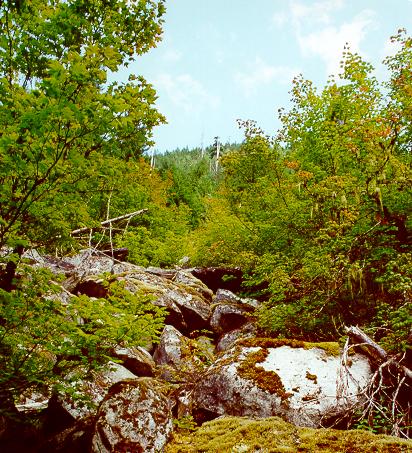Graduate Students:
Eva Boehringer MSc, 2002
What is the spatial extent to which vine maple affects certain physical and chemical soil properties in a coniferous old-growth forest stand?
Eva completed her Master of Resource Management from SFU in 2002. Previously, she completed an M.Sc. in Synthetic Organic Chemistry in 1996 at the University of British Columbia, and also has an undergraduate (B.Sc.) degree in Applied Chemistry from the University of Waterloo in Ontario, which she received in 1994.
RESEARCH SUMMARY
While much attention has been focused on nitrogen-fixing species such as red alder (Alnus rubra) as a means to improve site productivity, the effects of incorporating less prevalent species, such as vine maple (Acer circinatum) into coastal conifer stands have not been widely studied. Studies of the local effect of vine maple on forest soil have shown that this species may improve site fertility for surrounding conifers, because its litter contains higher concentrations of some nutrients (specifically N, P, Ca, Mg, K, Fe, and Zn), and decomposes faster than conifer litter.
However, no information is available to date on the spatial extent of these beneficial effects, nor on spatial pattern that may be imprinted onto the soil as a result of vine maple presence. Such questions are of direct relevance to forest managers, who seek to optimize positive species influence in mixed forest stands, while minimizing competition for vital soil resources at the same time.
To gain a better understanding of the influence of vine maple on forest soils, the objective of my research is to examine the spatial extent to which vine maple affects certain physical and chemical soil properties in a coniferous old-growth forest stand. In accordance with published literature on the spatial influence of broadleaf species, I am expecting to find a gradient of change in soil properties from vine maple influenced to conifer influenced soil with increasing distance from vine maple.
Using spatial and geostatistical methods, I am analyzing field data that was collected in the summer of 2000 to determine at what distance from the trunk vine maple influence on soil decreases. In addition, I hope to determine if vine maple imposes an individual influence pattern on the soil, and what the shape of this pattern is.
The results of this research will be directly applicable to forest management practices in coastal BC, and will hopefully lead to improved mixed species management by providing much needed information on the effect this broadleaf species on soil properties.
Publications:
Boehringer, E-M. 2002. Plot-scale spatial structure and variability of forest floor properties in an old growth stand of coastal British Columbia. M.Sc. thesis. Simon Fraser University, Burnaby, B.C.
